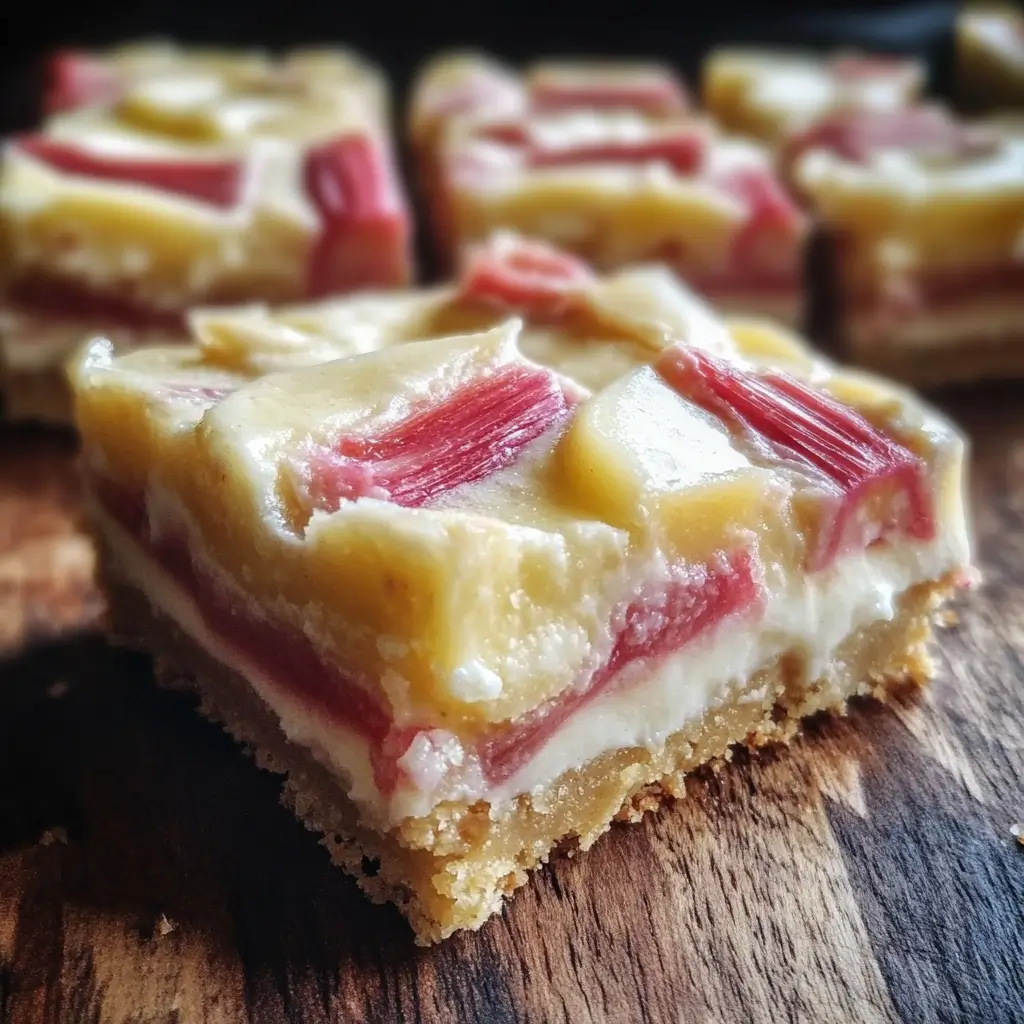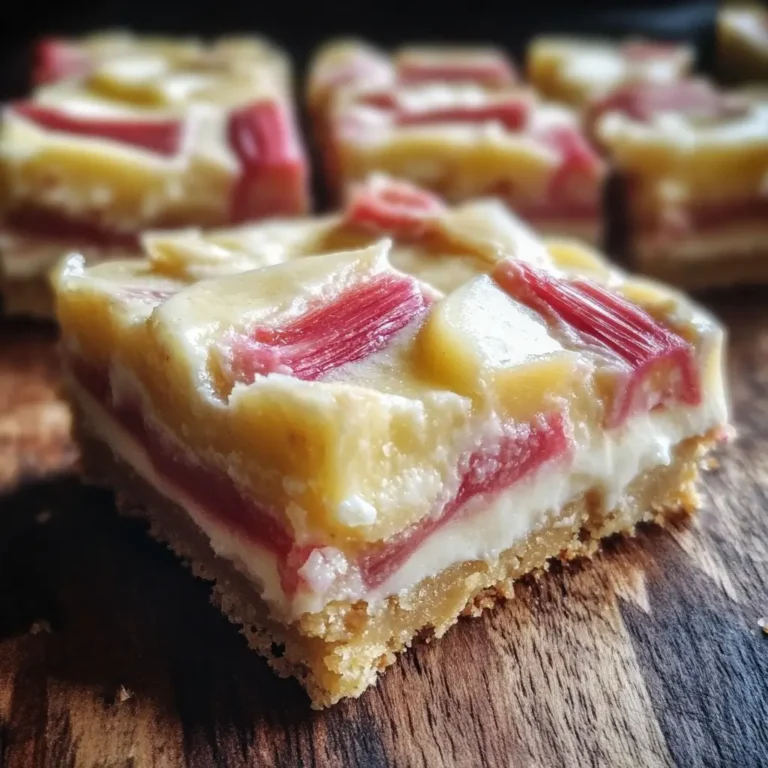Table of Contents
1. Introduction
As the days lengthen and the first blush of spring arrives, there’s a delightful tradition of baking with fresh, vibrant rhubarb. If you’re looking for a dessert that beautifully balances sweet and tart, with a satisfying array of textures, then these Rhubarb Custard Bars are your perfect answer. They are a true celebration of the season, transforming the unique flavor of rhubarb into a remarkably delicious and elegant treat.
These bars are a symphony of textures and flavors: a rich, buttery shortbread crust provides a sturdy, crumbly foundation, while the top layer boasts a smooth, creamy custard infused with tender, tangy rhubarb. A simple yet luscious frosting adds a final touch of sweetness and polish, making these bars utterly irresistible. They offer a delightful contrast that will tantalize your taste buds, reminiscent of the bright tang in our Lemon Bars Recipe: Easy Tangy Dessert, but with the unique character of rhubarb. Easy to make and transport, Rhubarb Custard Bars are an ideal choice for spring picnics, potlucks, or simply as a charming everyday dessert.
Whether you’re an experienced baker or new to working with this seasonal ingredient, this recipe guides you to a perfectly balanced and wonderfully satisfying result that celebrates the best of spring baking.
2. Recipe Summary Block
- Cuisine: American / Dessert
- Course: Dessert, Bar
- Difficulty Level: Easy-Medium (multiple components but straightforward steps)
- Prep Time: 20 minutes
- Cook Time: 50 minutes (10 minutes for crust + 35-40 minutes for custard)
- Total Time: 1 hour 10 minutes (plus cooling time)
- Servings: 16 bars
- Dietary Classification: Vegetarian (contains dairy, eggs). Can be adapted to be gluten-free (using certified gluten-free all-purpose flour blend) or dairy-free (using plant-based butter and heavy cream alternatives).
3. Equipment and Utensils Needed
To create your delicious Rhubarb Custard Bars, you’ll need the following kitchen tools:
- 9×13-inch baking pan: A standard rectangular baking pan is essential for baking the bars evenly. Glass or ceramic is ideal.
- Medium mixing bowl (for crust): For combining the flour, sugar, and butter for the crust.
- Large mixing bowl (for custard): For whisking together the eggs, sugar, flour, salt, vanilla, and cream.
- Whisks: At least two – one for whisking dry ingredients for the crust, and another for the custard mixture.
- Pastry blender or fork: For “cutting in” the cold butter into the flour mixture for the crust, creating that signature crumbly texture.
- Spatula or rubber scraper: For pressing the crust into the pan and for gently folding in the rhubarb.
- Electric mixer (optional but recommended for frosting): A handheld or stand mixer will make beating the frosting ingredients much quicker and smoother.
- Measuring cups and spoons: For precise ingredient measurements.
- Cooling rack: For allowing the baked bars to cool completely before frosting and cutting.
- Small bowl (for frosting): For mixing the frosting ingredients.
- Sharp knife: For cleanly cutting the cooled and frosted bars into squares.
4. Ingredients Section
Gather these fresh ingredients to create your delightful Rhubarb Custard Bars.
For the Crust:
- 2 cups (240g) all-purpose flour: The base for your buttery shortbread crust.
- 1/4 cup (50g) granulated sugar: Adds a touch of sweetness to the crust.
- 1 cup (227g) cold butter, cubed: Crucial for a tender, crumbly crust. Cut it into small cubes and ensure it stays cold before mixing.
For the Custard Filling:
- 2 cups (approx. 240g) diced fresh rhubarb: Use fresh, tender rhubarb stalks. Chop them into small, roughly 1/2-inch pieces for even distribution and cooking within the custard. Remember to discard the leaves as they are poisonous. For more on using rhubarb, explore our Fluffy Rhubarb Soufflé Pancakes recipe.
- 1 1/2 cups (300g) granulated sugar: Sweetens the custard and balances the tartness of the rhubarb.
- 4 tablespoons (30g) all-purpose flour: Helps to thicken the custard and bind it.
- 4 large eggs: Provide richness and structure to the custard.
- 1 teaspoon (5ml) vanilla extract: Enhances the overall flavor of the custard.
- 1/2 teaspoon (2.5g) salt: Balances the sweetness and brightens the flavors.
- 1 cup (240ml) heavy whipping cream: Adds richness and a smooth, creamy texture to the custard.
For the Frosting:
- 1 1/2 cups (180g) powdered sugar: Forms the base of the smooth, sweet frosting.
- 3 tablespoons (42g) unsalted butter, softened: Adds richness and helps create a spreadable consistency. Ensure it’s truly softened.
- 1/2 teaspoon (2.5ml) vanilla extract: Flavors the frosting.
- 2-3 tablespoons (30-45ml) heavy cream (as needed): Adjust to reach your desired frosting consistency.
Notes on Ingredient Preparation:
- Cold Butter: For the crust, cut the butter into small cubes and keep it in the refrigerator until you’re ready to use it. This helps create a flaky, crumbly texture.
- Rhubarb: Wash the rhubarb stalks thoroughly. Trim off any tough ends. If the stalks are very thick and fibrous, you can peel the outer layer, but for tender stalks, peeling isn’t usually necessary. Dice into uniform pieces.
5. Step-by-Step Instructions
Follow these detailed steps to bake your delicious Rhubarb Custard Bars.
1. Prepare the Crust:
- Preheat Oven & Grease Pan: Preheat your oven to 350°F (175°C). Lightly grease a 9×13-inch baking pan with butter or cooking spray.
- Combine Dry Ingredients: In a medium bowl, whisk together the 2 cups (240g) all-purpose flour and 1/4 cup (50g) granulated sugar.
- Cut in Butter: Add the 1 cup (227g) cold cubed butter to the flour mixture. Using a pastry blender1 or two forks, cut the butter into the dry ingredients until the mixture resembles coarse crumbs with some pea-sized pieces of butter remaining.
- Press into Pan: Press the crumbly mixture firmly and evenly into the bottom of the prepared 9×13-inch baking pan. Use the bottom of a flat-bottomed glass or your hands to ensure a compact, even layer.
- Bake Crust: Bake the crust in the preheated oven for 10 minutes. This par-bakes the crust, ensuring it’s firm and not soggy under the custard.
2. Prepare the Custard Filling:
- Whisk Custard Ingredients: While the crust is baking, in a large bowl, whisk together the 4 large eggs, 1 1/2 cups (300g) granulated sugar, 4 tablespoons (30g) all-purpose flour, 1/2 teaspoon (2.5g) salt, 1 teaspoon (5ml) vanilla extract, and 1 cup (240ml) heavy whipping cream until the mixture is smooth and well combined.
- Fold in Rhubarb: Gently fold the 2 cups (240g) diced fresh rhubarb into the custard mixture.
3. Bake the Rhubarb Custard Bars:
- Pour Custard: Carefully pour the custard mixture evenly over the hot, partially baked crust in the pan.
- Bake: Return the pan to the oven and bake for an additional 35-40 minutes, or until the custard is set. The center should no longer be jiggly, and the edges may be lightly golden.
- Cool Completely: Remove the pan from the oven and let the bars cool completely on a wire rack. This is a crucial step; the custard needs to set fully, and the bars must be cool before frosting. This can take 2-3 hours or longer. For a cleaner finish, you can chill the cooled bars in the refrigerator for at least an hour before frosting.
4. Prepare the Frosting:
- Beat Frosting Ingredients: In a small bowl, combine the 1 1/2 cups (180g) powdered sugar, 3 tablespoons (42g) softened butter, and 1/2 teaspoon (2.5ml) vanilla extract.
- Add Cream: Using an electric mixer (or a whisk), beat on medium speed, gradually adding 2-3 tablespoons (30-45ml) heavy cream, one tablespoon at a time, until the frosting reaches a smooth, creamy, and spreadable consistency.
5. Assemble and Serve:
- Frost the Bars: Once the rhubarb custard bars are completely cool (and chilled, if you chose that option), spread the prepared frosting evenly over the top.
- Cut and Serve: Use a sharp knife to cut the bars into 16 squares. For neat cuts, wipe the knife clean between slices.
- Enjoy! Serve immediately or store as directed.
6. Expert Tips and Variations
Enhance your Rhubarb Custard Bars with these expert tips and explore delicious variations.
Expert Tips from a Professional Chef:
- Cold Butter for the Crust: This cannot be stressed enough. Using very cold, cubed butter for the crust is essential for achieving that perfectly crumbly, tender shortbread texture. The cold butter melts slowly during baking, creating steam pockets that result in a flaky crust rather than a dense, greasy one.
- Chill Before Frosting: While letting the bars cool completely is necessary for the custard to set, chilling them in the refrigerator for an hour or two before frosting makes a significant difference. Cold bars prevent the frosting from melting or becoming too soft, allowing you to spread it smoothly and achieve a cleaner, neater finish when cutting.
- Don’t Overmix the Custard: Whisk the custard ingredients until just smooth and combined. Over-whisking can incorporate too much air, which might cause the custard to puff up excessively in the oven and then collapse or crack upon cooling.
- Patience with Cooling: Resist the temptation to cut into the bars too soon. Allowing them to cool completely, and ideally chilling, ensures the custard is fully set and the bars hold their shape beautifully when sliced.
- Uniform Rhubarb Dicing: Cut the rhubarb into small, consistent pieces (about 1/2 inch). This ensures the rhubarb cooks evenly within the custard and is distributed throughout each bar.
Common Mistakes to Avoid:
- Soggy Crust: This can happen if the crust isn’t baked long enough before adding the custard, or if the butter in the crust wasn’t cold enough.
- Unset Custard: Caused by underbaking. The custard should be set in the center, not jiggly.
- Cracked Custard: Often a sign of overbaking or cooling too quickly.
- Warm Butter for Crust: Using softened or melted butter for the crust will result in a dense, hard crust rather than a crumbly one.
Creative Recipe Variations:
- Flavor Boosts for Custard:
- Lemon Zest: Add 1-2 teaspoons of fresh lemon zest to the custard mixture. Lemon pairs exceptionally well with rhubarb, enhancing its bright, tart flavor.
- Spices: A pinch of ground cinnamon, nutmeg, or ginger can add warmth and depth to the custard.
- Topping Alternatives:
- Lemon Glaze: Instead of a creamy frosting, a simple lemon glaze (powdered sugar mixed with fresh lemon juice) can provide a lighter, tart finish.
- Streusel Topping: For a different texture, consider a streusel topping instead of frosting. Combine 1/2 cup (60g) flour, 1/4 cup (50g) brown sugar, and 1/4 cup (56g) cold butter (cubed) until crumbly, then sprinkle over the custard before baking.
- Fruit Combinations:
- Strawberry-Rhubarb: Replace half of the rhubarb with diced fresh strawberries for a classic sweet-tart combination. Adjust sugar if strawberries are very sweet.
- Blueberry-Rhubarb: Blueberries also pair well with rhubarb, adding another layer of flavor and color.
- Gluten-Free Option: Substitute the all-purpose flour in both the crust and the custard with a 1:1 gluten-free all-purpose baking flour blend (ensure it contains xanthan gum for best results).
- Vegan/Dairy-Free Option: Use plant-based butter alternatives for the crust and frosting, and a vegan heavy cream substitute for the custard. Note that texture may vary slightly.
7. Serving Suggestions
These Rhubarb Custard Bars are a delightful dessert that can be enjoyed on various occasions, from casual gatherings to more formal events.
- Plating and Presentation: Once completely cooled and frosted, cut the bars into neat 16 squares. Arrange them attractively on a serving platter. The vibrant pink rhubarb peeking through the creamy custard and white frosting makes for an appealing presentation.
- Complementary Pairings:
- Beverages: These bars pair wonderfully with a cup of freshly brewed coffee, a comforting cup of tea, or a glass of cold milk. For a special occasion, a light dessert wine or a sparkling rosé would also be a lovely accompaniment.
- A La Mode: For an extra indulgence, serve the bars slightly chilled or at room temperature with a scoop of good quality vanilla bean ice cream or a dollop of whipped cream.
- Occasions: Rhubarb Custard Bars are perfect for:
- Spring and summer gatherings, picnics, and BBQs
- Potlucks and bake sales
- Family dinners and dessert buffets
- Mother’s Day or other special occasions
- An everyday sweet treat to enjoy with coffee or tea.
8. Nutritional Information (Per Serving)
Nutritional information is approximate and can vary based on specific ingredients and portion sizes used.
Estimated Nutritional Breakdown (per bar, assuming 16 servings):
- Calories: Approximately 290 kcal
- Protein: Approximately 4-5g
- Fat: Approximately 17-20g
- Saturated Fat: 10-12g
- Unsaturated Fat: 7-8g
- Carbohydrates: Approximately 30-35g
- Sugar: Approximately 20-25g
- Fiber: Approximately 1-2g
- Sodium: Approximately 90-120 mg (can vary based on salt content in butter and added salt)
These Rhubarb Custard Bars are a rich and satisfying dessert. As a delightful treat, they are best enjoyed in moderation as part of a balanced diet.
9. Storage and Reheating Instructions
Proper storage ensures your Rhubarb Custard Bars remain fresh and delicious.
- Proper Storage: Once completely cooled and frosted, store the bars in an airtight container.
- Refrigeration Guidelines: Due to the custard filling and cream cheese frosting, it is essential to store these bars in the refrigerator. They will last for up to 3-4 days.
- Freezing Recommendations:
- Baked Bars (without frosting): You can freeze the baked and cooled bars before frosting them. Wrap the entire slab tightly in plastic wrap, then in aluminum foil. Alternatively, cut them into individual squares, wrap each tightly, and store them in a freezer-safe container. Freeze for up to 2-3 months.
- Assembled & Frosted Bars: While technically possible, freezing fully frosted bars is generally not recommended. The frosting might change in texture, and the custard might become slightly watery upon thawing. If you do freeze them frosted, wrap them very well to prevent freezer burn and moisture absorption.
- Thawing Frozen Bars:
- Thaw frozen bars (frosted or unfrosted) in the refrigerator overnight.
- If unfrosted, apply the frosting once thawed and chilled.
- Reheating:
- These bars are typically served chilled or at room temperature. They are not typically reheated, as warming them could melt the frosting and alter the custard’s texture.

10. Frequently Asked Questions (FAQ)
Here are some common questions about making and customizing your Rhubarb Custard Bars:
- Can I use frozen rhubarb? Yes, you can use frozen rhubarb. Thaw it completely first, then drain any excess liquid. This prevents the bars from becoming too watery. Chop it to the recommended size if necessary.
- Why is my custard not setting? An unset custard is usually due to underbaking. Ensure the custard is no longer jiggly in the center before removing it from the oven. Oven temperatures can vary, so it might need a few extra minutes. Also, make sure your eggs are large, as they provide crucial binding.
- Can I make these bars gluten-free or dairy-free? Yes, you can. For gluten-free, substitute the all-purpose flour in both the crust and custard with a 1:1 gluten-free baking flour blend. For dairy-free, use a plant-based butter alternative (ensure it’s suitable for baking) and a plant-based heavy cream substitute.
- What kind of pan should I use for baking? A 9×13-inch metal, glass, or ceramic baking pan works well. Glass or ceramic pans typically retain heat longer, so you might need to reduce baking time by a few minutes.
- Can I skip the frosting? Yes, you can definitely skip the frosting if you prefer a less sweet bar or want to highlight the tartness of the rhubarb. A simple dusting of powdered sugar or a light lemon glaze (powdered sugar mixed with lemon juice) would also be lovely.
- How do I cut neat bars? For neat, clean cuts, ensure the bars are completely cooled, and ideally chilled, before cutting. Use a sharp, thin-bladed knife. For best results, wipe the knife clean with a damp cloth between each cut.
These Rhubarb Custard Bars are a delightful celebration of spring’s bounty, offering a perfect balance of flavors and textures that will make them a memorable addition to your dessert repertoire. Enjoy the baking process and the delicious outcome!

